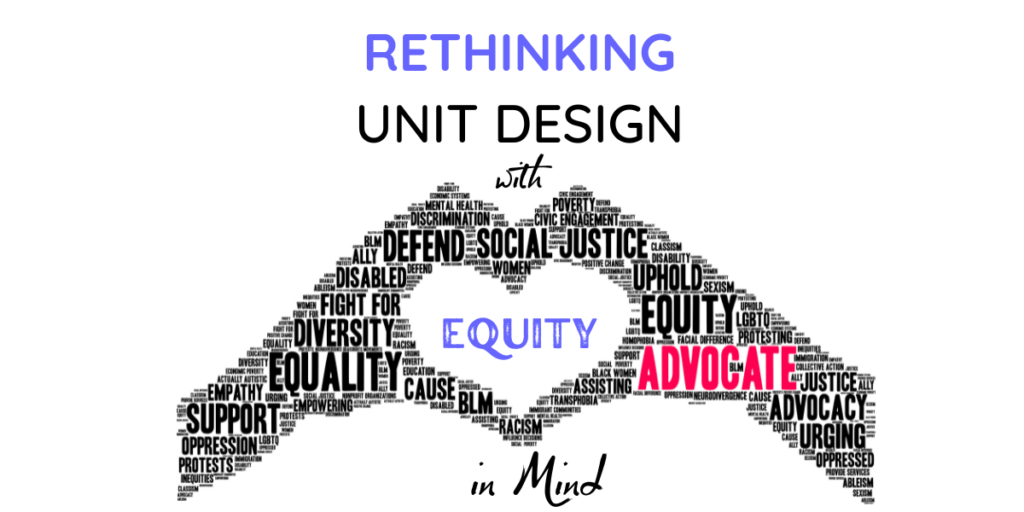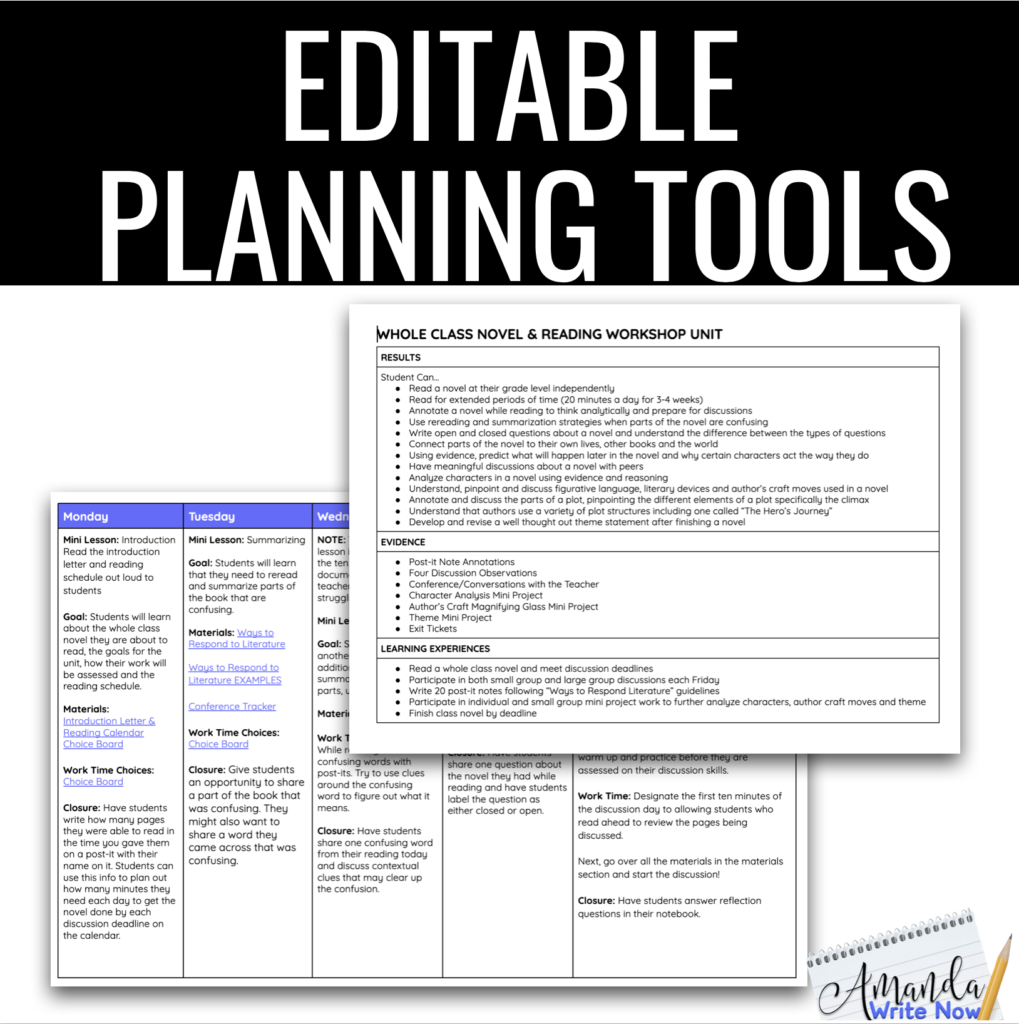
In this six-part series, I outline exactly how I’m rethinking my workshop classroom with an equity lens. You can find the other parts of this series here:
Part 1: Rethinking Writing Workshop with Equity in Mind
Part 2: Rethinking Reading Workshop with Equity in Mind
Part 3: Rethinking Conferencing with Equity in Mind
Part 4: Rethinking Unit Design with Equity in Mind
Part 5: Rethinking Writing Assessment with Equity in Mind
Part 6: Rethinking Elementary and Secondary Reading Instruction and Assessment
Before we get started with part 4, we need to define workshop and we need to define equity. Here is my very brief definition of both…
Workshop– a method of teaching that empowers students to become readers and writers in and outside of the classroom. This method of teaching involves a system wherein students work toward publishing pieces of writing and developing identities as readers by choosing the books they are interested in. Workshop also prioritizes developing a supportive community of readers and writers.
Equity-the act of treating people fairly. This is not to be confused with equality which is treating people equally. Our students are all unique and have different needs, so treating them all equally is just not possible, but treating them fairly and with their individual needs in mind is possible.
Now that we are on the same page about what workshop and equity mean, let’s get started with thinking about unit planning
Problem
One Size Fits All Unit Planning
Traditionally, when planning units English teachers follow a set curriculum in order to teach a book or how to write a particular genre. The learning activities are chosen by the teacher and all students are expected to do the activities. At the end of a unit, all students have to exhibit their learning in one way.
English teachers prioritize writing, reading, and literacy above all else. You might be thinking, well of course they do, that’s what English is all about! This is how things have been done for centuries and it’s problematic.
It’s problematic because times have changed and our students come from diverse backgrounds and have varying strengths and weaknesses. Many of our students come to us with very negative experiences with reading and writing or very little experience. And the fact is, technology has transformed the ways in which we communicate and learn. Having legible handwriting, knowing grammatical terms, and being able to read and understand the classics shouldn’t be the most important priorities in English classes anymore.
Students can now communicate their ideas through a vast array of different mediums. They are becoming more and more adept at video editing, using digital apps like Canva or Adobe Spark Pages, and working with their hands or with technology via STEM projects. Teachers have to quit planning one-size fits all units if they want students to build on the strengths and interests of the students in front of them. But, how?
A Possible Solution
Universal Design for Learning or UDL is the way forward if we want to stop one-size-fits all unit planning. UDL is a method of planning units that incorporates student choice and voice every step of the way. Below, are the main steps of the UDL planning process based on a book called Equity by Design: Delivering on the Power and Promise of UDL by Mirko Chardin and Katie Novak. *This is an Amazon Affiliate Link, meaning you won’t be charged anything extra when purchasing the book however I will receive a commission if you purchase the book!
- Identify the goal.
The goal of the unit can come straight from your state standards. This part is fairly easy. - Involve students when planning your unit.
You can pose the following questions to students as you begin designing your unit:- What do you think you need to know or do to be able to meet this goal?
- How would you best like to learn it?
- What materials can I provide you that will help you meet this goal?
- How will you share with me that you met the goal?
- Plan your curriculum buffet style.
Once you find out how students would best like to learn, you will have much more direction when implementing this part of the UDL process. Students can learn in a variety of ways. See solutions to problem #2 for a variety of learning activities students can engage in during your unit. - Reflect/Repeat
After a unit, we often feel pressed for time and move on, and very little reflection occurs. This is a huge missed opportunity. Reflection allows for the teacher and students to learn and improve on the process for the next unit. Students can share what worked well for them and what didn’t go so well. The teacher can take all of this into consideration when beginning to plan for the next unit.
All of the units I’ve designed included editable planning tools. The image displayed below shows the expected results of my Whole Class Novel Reading Workshop Unit. Students can provide input about how they feel they can accomplish the results/goals of the unit and you can type student feedback directly into the document!
Problem
One-Size Fits All Learning Activities
What are “One Size Fits All Learning Activities” and Why is it a Problem?
When planning a unit we tend to choose one mode of learning for all students. For example, everyone must read one book and respond to it in one way, such as through annotation via sticky notes. Everyone must watch a video chosen by the teacher and take notes. Or everyone must brainstorm ideas the way the teacher modeled or draft their argumentative essay in the same step-by-step process the teacher went over during a mini lesson. This makes sense because it is efficient. There’s only one teacher and 30+ students, so how can one teacher be responsible for creating an array of learning activities to learn one concept in a unit and then be expected to do that with another concept in the same unit? It seems a bit unrealistic given the time crunch many teachers face when teaching a unit.
A Possible Solution
All of my units contain choice boards. A choice board is a list of options for students to choose from based on their interests and learning styles. Choice boards are fairly easy to create and can contain multiple options for students to learn/practice the skill you are trying to teach. Here is a list of learning activities students can engage in during your unit to practice and learn the skill/standard you are trying to teach:
- Watch an educational video.
- Listen to a podcast or news broadcast.
- Choose from a variety of articles based on student interest.
- Choose from a variety of books based on student interest.
- Choose from a variety of picture books/magazines based on student interest.
- Watch a pre-recorded lesson by the teacher.
- Play an online educational game related to the skill/standard.
- Take personalized notes (choose from sketchnotes, Cornell, the outline method or a mind map).
- Work in collaboration with a partner.
- Work in a small collaborative group
This Choice Board is an editable Google Slideshow for my Whole Class Novel Reading Workshop Unit. All of my units included at least ten editable slides for each day of the unit. Each slide has a list of choices for work time.
Problem
One-Size Fits All Formative and Summative Assessments/Performance Tasks
What is “One Size Fits All Assessments” and Why This is a Problem?
When planning units we tend to expect students to perform the exact same task to show their learning. Writing an essay, participating in a Socratic Seminar, giving a presentation or taking a test are all traditional learning tasks that students must perform to demonstrate their learning. The problem again is that students who have natural talent and experience with these performance tasks will obviously do better (and have an advantage) over students who don’t necessarily have these talents or past experiences performing in these ways.
Possible Solution
Just as you give students an array of options for learning, give them an array of options for demonstrating their learning. It’s important to consider the depth of knowledge or DOK your students are demonstrating in this assessment first though. This handy PDF encapsulates the depths of knowledge categories very well. There are four categories:
- Recall/Reproduction-repeat what was learned
- Skill/Concept-use the skill or concept information in a similar situation
- Strategic Thinking-draw conclusions and develop a plan using the information learned
- Extended Thinking-design or conduct an experiment related to the skill or concept
Once you’ve determined which category of depth of knowledge you want students to demonstrate in your formative/summative assessment you can provide a variety of choices via a choice board again. Here’s an example of choice board for a formative assessment showing the skill of determining the theme of a narrative text at the strategic thinking depth of knowledge level:
- Create a sketch of two short stories with similar themes. Provide evidence of the theme with quotes from the text in your sketch.
- Record yourself talking about the main theme of two short stories and how the two authors approach the theme. Provide evidence of the theme with quotes from the text in your recording.
- Write a brief essay about the theme of two short stories. Provide evidence of the theme with quotes from the text in your essay.
- Create a song/performance/speech about two short stories with similar themes. Provide evidence of the theme with quotes from the text in your speech.
- Take a quiz about two short stories with similar themes. Be prepared to provide evidence of the theme with quotes from the text.
- Have another idea about how you can show your learning? Fill out a Google Form telling me how you’d like to demonstrate what you learned.
These assessment tools are editable and from my Whole Class Novel Reading Workshop Unit. All of my units included editable assessment tools!
Wrap Up
Unit planning shouldn’t be done independent of our students. The more we can incorporate student voice into the unit planning process the more equitable our unit planning becomes. We must begin to pivot away from one-size fits all learning activities and one-size fits all formative/summative assessments. We can do this by surveying our students and giving them a buffet of options via a choice board when engaging students in learning activities and assessments. In the comments, let me know, how has your planning process evolved over the years? How are you going about incorporating more student voice and choice in your unit plans? These things are not easy to hear or implement. So, if you are considering taking this one this year, don’t feel like you have to do it all at once. Even giving two choices is better than nothing. I’d love to hear your thoughts on these important matters.




0 Comments